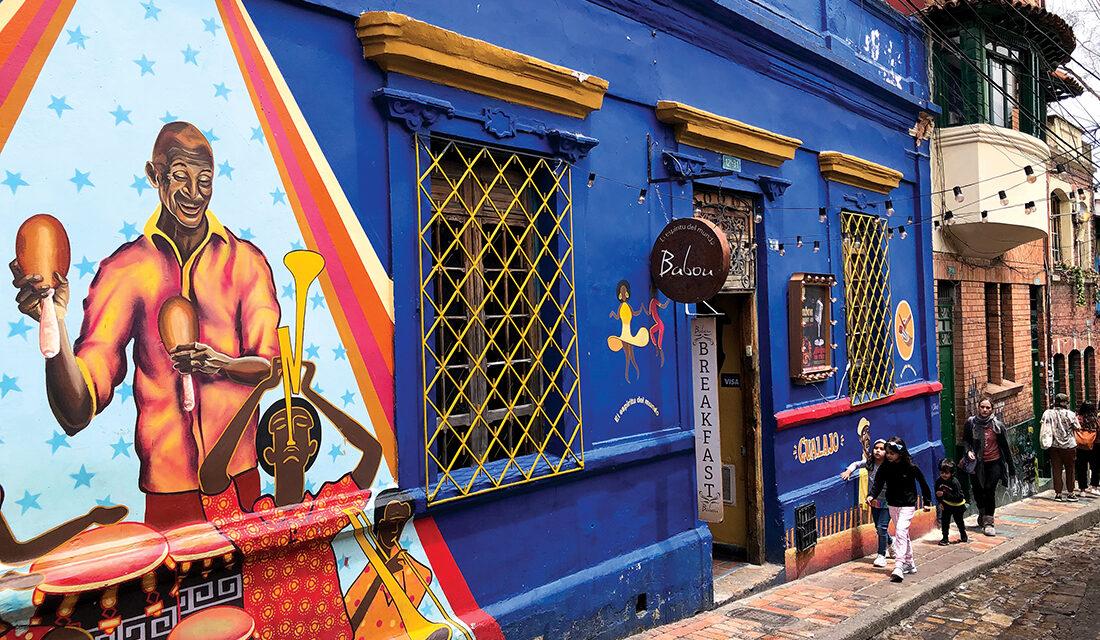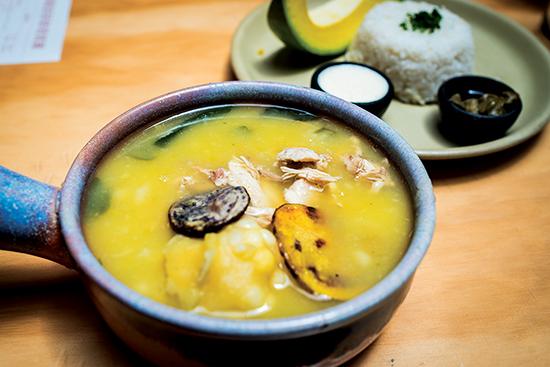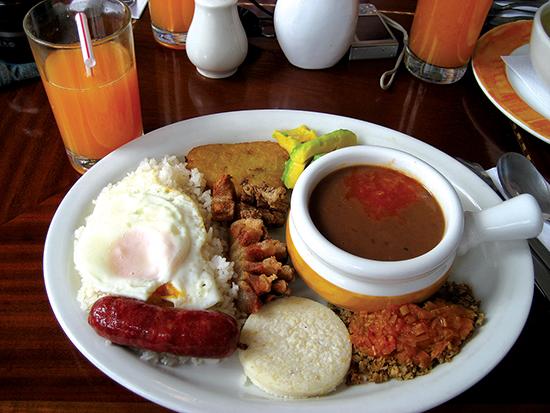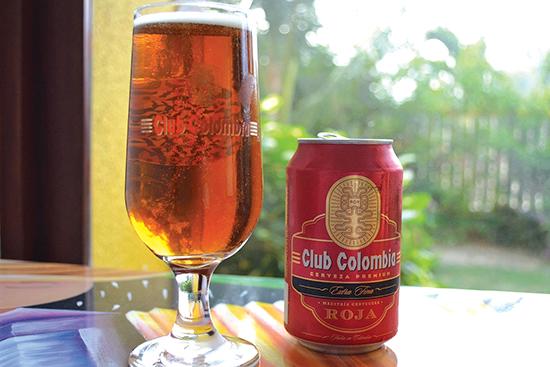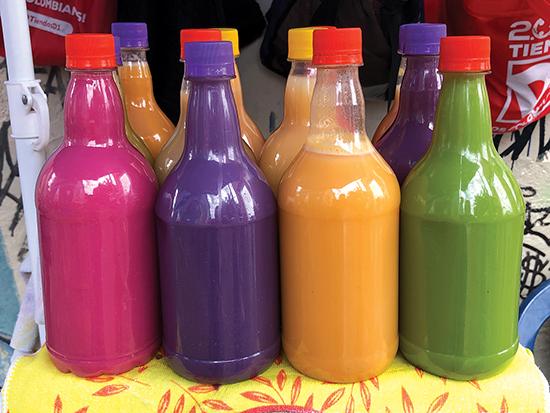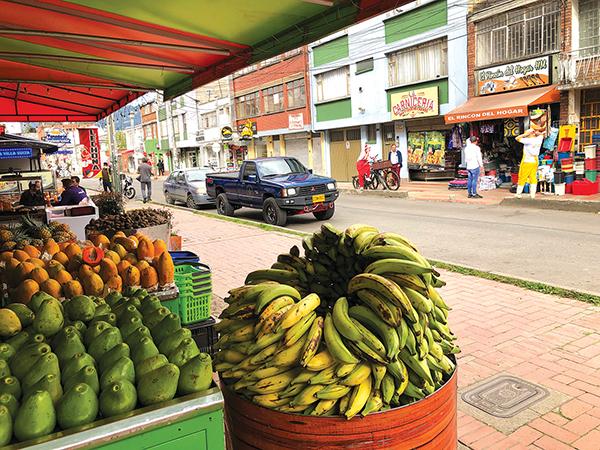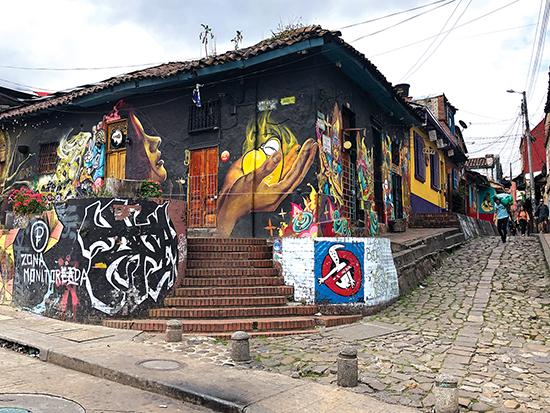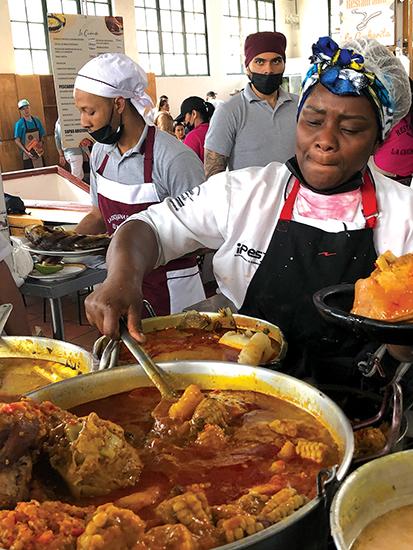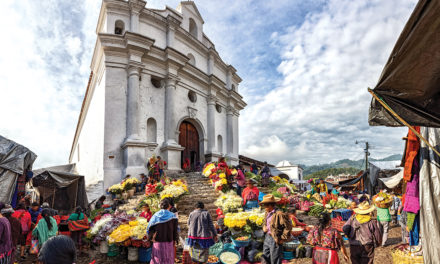Colombia
Flavors of Colombia
Article and photography by Randy Mink
Savor traditional foods and beverages at Bogota’s street carts, markets, restaurants and cafes
It seems as if you can’t walk a block in central Bogota without running into a fruit market, sidewalk juice stand or mom-and-pop cafe. And you’re never far from a street vendor serving up that classic Colombian corn cake, the arepa, hot off the griddle.
Not long after their arrival in this sprawling, traffic-choked capital cradled by the green slopes of the Andes, first-time visitors seeking to sample native foods inevitably find themselves biting into an arepa. Colombia’s version of a tortilla, the ubiquitous patty of cornmeal and butter is usually grilled plain or filled with a sweet cheese, or sometimes with egg, ham or chicken. Arepas can be a snack, light breakfast or starchy accompaniment to a sit-down meal.
Corn plays a part in many Colombian dishes with Andean influences, as do meat and potatoes. Food in this South American country is basically peasant fare, simply prepared and gently flavored.
Traditional Favorites
Bogota’s most famous dish is the beloved ajiaco santafereno. A hearty meal in a bowl, ajiaco is a chicken and potato stew with small pieces of corn on the cob. It is flavored with guascas, a wild herb native to the Andes, and often garnished with capers and a dollop of sour cream. Ajiaco is popular with tourists dining at La Puerta de la Cathedral, a restaurant located in a historic, high-ceilinged building around the corner from the main cathedral. Specializing in traditional Colombian cuisine, it is just steps from Plaza de Bolivar in La Candelaria, the atmospheric Spanish colonial district. Its narrow cobbled streets brim with churches, museums, handicraft shops and 300-year-old houses.
Many in my tour group at La Puerta ordered the ajiaco, but I went for the bandeja paisa, another signature Colombian dish that satisfies big appetites. The platter of chorizo, fried pork belly (chicharron), pulverized beef, rice, beans and baked plantain is topped with a fried egg and comes with an arepa and a slice of avocado.
Sample This Corn Brew
One day we took a tour called “Bogota Like a Local,” which exposed our group to more Colombian food and drink specialties. During a tasting session at La Candelaria’s Casa Galeria Cafe, we sampled a fermented corn drink called chicha and were surprised to learn that Colombia grows 60 different types of corn, a grain that for centuries has been an important part of the heritage of indigenous people in the Andes. The corn brew is slightly bubbly, thick and most commonly yellow.
As our Casa Galeria host told us, chicha has religious origins. Long ago, it was made by the local wise man, who would chew the corn off the cob and then let it ferment in a pot—in his saliva!—for 15 days. Villagers who partook of the brew supposedly were drinking knowledge. Over the years, the idea behind imbibing chicha evolved into the secular, and chicha became associated with drunkenness and stupidity. In fact, after a political revolution in 1948, in which 70 percent of Bogota was burned, drinking or producing chicha was declared forbidden. To this day, the drink is still on the books as being illegal, though the law is not enforced.
The chicha we had at Casa Galeria was from an ancient recipe from the cafe owner’s family. Following tradition, we drank from a gourd cup with a string attached. Our brew (made only with corn, no water) was fermented for only two or three days and had an alcohol content of 2 percent, but vendors up and down the street, a colorful stretch filled with artistic graffiti, sell bottles of chicha with 4 or 5 percent alcohol (though it can go up to 12 percent). And it comes in many different flavors in a rainbow of colors. At night, students flock to the chicha bars surrounding Plaza de Chorro de Quevedo, the lively hub of the graffiti district.
Other Drinks to Try
Our Casa Galeria session featured other drinks, including Club Colombia amber beer (paired with orange slices, strawberries and caramel brownies), the premium brand made by Bavaria, the country’s only industrial-scale brewery. We also sipped Chela, a locally made, small-batch coffee beer that has chocolate in it.
At a sidewalk cafe near my hotel, I tried another local drink—refajo. A strange combination of cola and beer, it helped wash down my empanadas bogotanas, pockets of fried corn dough filled with potatoes and stewed beef. Empanadas are found in every South American country, but the ones in Colombia, crisp and golden with a nice crunch, are on the small side (so you can order more and try different fillings).
For a souvenir, I brought home a small bottle of aguardiente, Colombia’s heavy-hitting spirit. Translated “fiery water,” the clear, anise-flavored liquor is made from sugarcane.
You can’t discuss Colombian beverages without mentioning its famed coffee. Locals enjoy un tinto (black coffee) any time of day. Walking around La Candelaria, I spotted a Juan Valdez cafe, one in a chain of Starbucks-like coffee shops named after the fictional character that many North Americans remember from TV commercials way back when. Whereas Colombia once exported almost all of its best coffee beans and few Colombians drank coffee at cafes, the local coffee scene has improved immeasurably in the last 15 years, with trained baristas staffing some 50 coffee shops in Bogota alone.
Festival of Fruits
I’m not big on vegetables but do love fruits, and in Colombia you can have a different fruit every day of the year. Many of them are not found in other parts of the world. You’ll find common tropical fruits like mangoes, pineapples, papayas, passion fruit, bananas and guava, but also unfamiliar ones with names like feijoa, curuba and granadilla. The latter is an orange-yellow fruit with slimy gray contents. Guanabana (or soursop) is a large, spiky, rather intimidating “dinosaur egg” filled with sweet, milky white flesh. The green higo (prickly pear) comes from a cactus variety and has a sweet, orange-colored meat. The bittersweet lulo, orange on the outside and bright green on the inside, is often consumed in the form of a water- or milk-based juice, as are many of the other fruits.
Our “Bogota Like a Local” group had a chance to sample the fruits of Colombia at a sit-down session at La Perseverancia Market Square, a famous produce market dating back to 1940. The photo-worthy, 80-stall market is a common stop on gastronomy (and general) tours of Bogota. Its restaurant serves up traditional Colombian fare, including ajiaco santafereno, bandeja paisa, steaks, soups, and various seafood and fish dishes.
Just walking down the street in Bogota triggers hunger pangs. You’ll see pushcart vendors cooking hamburgers, slicing mangoes, grinding sugarcane into juice, or grilling corn on the cob (mazorca) and skewers of meat.
In La Candelaria, I couldn’t resist the ladies selling obleas, which are big flat wafers filled with arequipe (milk caramel), berries or whipped cream. Many years ago when the Rolling Stones were in town, lead singer Mick Jagger bought an oblea, and even now many of the carts bear his caricature (complete with flabby lips), a sort of celebrity endorsement.

